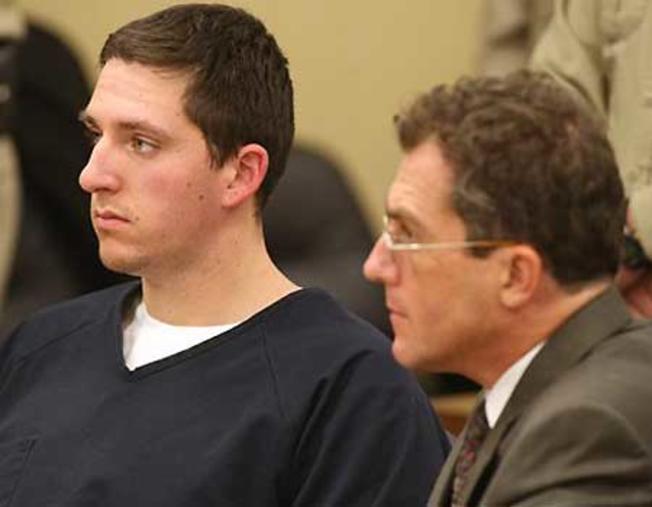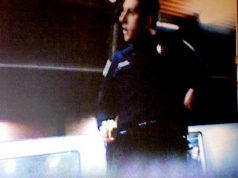
(6/10) — 23:30 PDT — LOS ANGELES — Opening statements were presented in a Los Angeles courtroom Thursday morning in the historic second-degree murder trial of former BART Police Officer Johannes Mehserle, who shot unarmed BART passenger Oscar Grant on New Year’s Day 2009.
The trial marks the first time a police officer in California has been tried for murder for a killing committed while on duty.
- Aidge Patterson and other activists with the LA Coalition for Justice for Oscar Grant gather outside the Downtown Los Angeles courthouse where opening statements were held in the second-degree murder trial against Johannes Mehserle.
- Rev. Keith Muhammad (left), is joined by Oscar Grant’s mother, Wanda Johnson, and uncle, Cephus Johnson, during a midday press conference in Los Angeles.
Alameda County Deputy District Attorney David Stein, the prosecutor in the case, argued in his opening statement that Mehserle intended to shoot Grant. He also said that, contrary to defense assertions that Mehserle mistook his gun for his Taser, Mehserle knew the difference between the two weapons.
Stein presented several videos of the shooting captured by passengers who were present at the Fruitvale BART station that night to the jury. He also showed videos compiled by the District Attorney’s Office which demonstrate the differences between drawing a gun and a Taser.
“[The gun] only comes out when you want it to come out,” Stein said, explaining the various fasteners one must undo to release a gun from its holster.
Stein said it was emotion and police aggression that caused Mehserle to purposefully draw his gun, point it at Grant and fire a single shot into his back.
“There is an emotional as well as physical component to every arrest,” Stein said. “When that emotional component is not held in check, bad things happen.”
For much of his statement, Stein focused on former BART Police Officer Tony Pirone, whom witnesses say acted aggressively that night and was both physically and verbally abusive to Grant and his friends.
“What happens when an officer or group of officers think their duty is other than to protect and serve? […] When they think they have a right to abuse who they come into contact with?” Stein said. “The result will always be chaos, distrust and disorder.”
Stein said Mehserle and Pirone had a close, “big brother” type of relationship and that the senior officer had been a mentor to Mehserle.
In his opening statement, defense attorney Michael Rains agreed that passengers that night “were unhappy with the actions of Officer Pirone.” But “Mehserle is on trial, not Pirone,” he said.
His client, Rains said, was only on the platform for two and a half minutes before the shooting.
Rains said that, while Grant’s killing was tragic, Mehserle did not intend to shoot and kill him and is already paying for his actions, if not behind bars.
Rains said he would present evidence that some of Grant’s friends heard Mehserle shout “I can’t get his hands, I’m going to Tase him” just before he shot Grant.
“For the rest of his life he will be trapped in a wretched prison of his vivid and painful memories” of that night, Rains said.
The 28-year-old, who was born in Germany before moving to the United States at the age of four, wanted to study computer programming before changing his mind in college and enrolling in a police academy, Rains said.
Rains asserted that the six hours of instruction in Taser use that BART gave Mehserle was insufficient, but said he had extensive training in using firearms. Mehserle spent countless hours at the Napa Police Academy, where he first learned how to use firearms, practicing the use of his gun, Rains said.
Sides clash on whether Grant resisted arrest
“Oscar Grant was not resisting. He was in the process of putting his hands behind his back” at the time of the shooting, Stein said. He argued that Grant and his friends were cooperative and that BART Police officers used excessive force throughout the incident.
Rains said while the prosecution believes that the videos demonstrate that Grant was not resisting arrest, he will argue the footage actually shows Grant “actively resisting arrest”.
He said Mehserle and Grant wrestled on the ground for 12 seconds before the shooting occurred and said the young men had acted aggressively toward the officers.
“Punches were being thrown by a lot of different people,” Rains said.
Grant’s mother Wanda Johnson, who left the courtroom shaking her head after Rains’ statement, said the allegations were completely false.
“The police didn’t have one report that those boys did all of that,” she told the Beat.
Witnesses describe “commotion”
Witness testimony began during the afternoon session with Vicki Long, a video technician from the Alameda County D.A.’s office, who described the process of enhancing the videos recorded by bystanders that night.
She was followed by Margarita Carazo and Karina Vargas, two witnesses who captured the events leading up to the shooting on video. Stein had each witness review clips of the footage they had captured.
Vargas told jurors she was compelled to begin recording the encounter between police and Grant because she believed Pirone was acting inappropriately.
Pirone was “using foul language,” and his “aggressiveness compelled me to record,” she said.
Carazo said when the doors of the BART train opened that night, she saw a “commotion with the cops and the people on the platform.”
More video of the incident is expected to be shown in court Friday.
Juror removed from panel
In a surprise move before opening statements even began, a young Hispanic woman was dismissed from the jury “for cause” after the prosecution and defense conferred in private with Judge Robert Perry. No public explanation was given, and an older Hispanic woman replaced her.
The final jury was seated Tuesday in a quick selection process. There are eight women and four men on the jury. No African Americans are seated on the panel.
The trial has been moved to Los Angeles due to concerns over whether a jury without preconceived notions of the case could be found in the Bay Area, given the intense publicity the case has received. It is expected to last two to four weeks.











